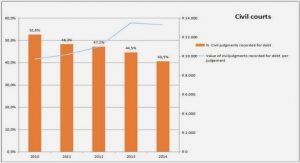Get Complete Project Material File(s) Now! »
On the application of parameter identifiability to the security of chaotic synchronization
As mentioned in Chapter 2, a fundamental assumption of all kinds of cryptosystems, as first stated by A. Kerckhoff [62], is:
• public structure: an opponent knows the structure of the encryption system and the a priori probability of the key that is used. This requirement is referred to as Kerckhoff’s principle.Kerckhoff’s principle means that the intruder knows the details of the cryptosystems, including the design and the implementation, except the secret key. That is, the security of the cryptosystem should depend only on the key. In many proposed chaotic synchronization schemes, some initial conditions and parameters are treated as the key. It is believed that recovering the hidden message is difficult without the exact values of the key. Hence the security of the parameter is an important problem for chaotic synchronization.
The authors in [52] claimed that it is very difficult to find an identifiable parameter by a brute force attack (exhaustive search of the key space), because the uniqueness of the parameter is directly linked to the parameter identifiability concept. Hence this kind of parameter vector may be a good choice for the secret key. However, this claim is incomplete. Identifiability describes the one-to-one property of the map from the parameter to the measured output. Therefore the identifiable parameter is harmful to the security of the parameter. The authors in [63] made use of the notion of identifiability and parameter identification technique to estimate the parameters by the output. There are other different methods to realize parameter identification [64, 65, 25]. The above results show that that identifiable parameter is not a good choice for the key.
To protect the parameter against all kinds of parameter identification techniques, the identifiability of the parameter should be checked during the design of a chaosbased communication scheme. To test the identifiability, the authors in [52] used the input/output relation approach based on a technique of Gr¨obner bases and a characteristic set for polynomial systems. However, it is very complex to compute Gr¨obner bases or characteristic set for general polynomial systems. This section uses definitions of identifiability and the linear algebraic method based different 1-forms introduced in [39, 40]. This method simplifies the computation and deals with systems described by meromorphic functions, which are more general than the polynomial systems discussed in [52].
In order to discuss the security of chaos-based communication schemes, [24] introduces the concept of secure synchronization. This definition requires the synchronization to be antiadaptive secure and antirobust secure. However, it is difficult to verify these two properties. If one system parameter is not identifiable, it is obvious that there is no adaptive observer which can estimate the real parameter value. Hence this kind of system satisfies the antiadaptive property to a certain extent.
Improving the security of chaotic synchronization with a ∆-modulated cryptographic technique
Based on conventional cryptographic techniques, various chaos-based schemes have recently been developed [16, 17]. A common feature of these methods is the utilization of state variables of the chaotic systems as keys in the encryption algorithms. For parameter modulation schemes, more secure methods were proposed in [70, 68]. In this section, a modified parameter modulation scheme is proposed to improve security further. The numerical simulation shows that two popular attacks are ineffective when using the modified parameter modulation scheme and the parameter has a high degree of security. In this modified parameter modulation scheme, a continuous chaotic system with a parameter is used to transmit encoded message. The parameter is generated by a cryptosystem which offers it many choices corresponding to transmitted bit ‘0’ or ‘1’, and thus protection against power analysis and return map attack. The cryptosystem is constructed by using a one-dimensional discrete-time system controlled by a ∆-modulated feedback, which is quite different from [18] that uses a logistic map. The first reason why the proposed scheme uses this ∆-modulated system is the simplicity and speciality of ∆-modulation, which makes it an attractive choice for control practitioners. Yet, little attention has been paid to the chaotic property of this kind of system. Another reason is that the result can easily be extended to high-dimensional ∆-modulated control systems, which will make the cryptosystem more secure. The complex behaviour of this simple control system due to ∆-modulated feedback has been investigated in [71], [72]–[73]. When some parameter a > 2 in this particular onedimensional discrete system, the system is chaotic [74, 72] but not a self-map. Note that the construction of a cryptosystem needs a self-map. In this section, the system is proved to be chaotic and also a self-map when a∈(√2,2].
Subsection 4.2.1 proves that the one-dimensional discrete system controlled by a ∆-modulated feedback is chaotic when the parameter a ∈ (√2,2]. Then two basic requirements for security and the framework of proposed method are given in subsection 4.2.2. With the help of the Lorenz system and a secure cryptosystem based on a ∆modulated feedback control system, the modified parameter modulation scheme is also illustrated in detail in subsection 4.2.2. Finally, the security of this scheme is analyzed by numerical simulations.
BER performance with perfect synchronization
Perfect synchronization means that the synchronization channel is not corrupted by noise. To evaluate the statistical performance of the proposed scheme, 213 binary data are generated randomly. In Figure 5.5 and 5.6, the length of spreading sequences is N = 64. Figure 5.5 shows that the reduction in the BER is in relation to the increase in SNR, where the number of users K equals 20 and 25, respectively. By assuming that the highest acceptable level of BER equals 10−3 [95], it can be observed that the performance is satisfactory when the SNR is greater than 5. Figure 5.6 plots the performance of the BER when the number of users K = 30, 35 and 40. The level of noise SNR ranges from -10 to 20. These figures show that the performance of the BER becomes worse when the number of users increases. The performance is satisfactory when the SNR is greater than 10. Figure 5.7 plots the performance of the BER when the length of spreading sequences N equals 128. In order to investigate the influence of the encryption algorithm on the BER performance, all these figures include two lines. One line is the performance of the BER without the encryption/decryption process. The other is the performance of the BER with the encryption/decryption process. One ciphertext block influences not only the corresponding plaintext block, but also the next block. Hence the improvement of security degrades the performance of the BER. Figure 5.8 compares the BER performance when the length of spreading sequences is N = 64 and N = 128, respectively. These figures show that the longer the length, the better the BER performance is.
Assessment
In this thesis an adaptive observer is constructed for the generalized Lorenz system with an unknown parameter, which shows that it is not easy to choose a good candidate for secure synchronization. Yet this result does not provide positive suggestions for designing a secure communication scheme. Hence identifiability is chosen to test whether system parameters are suitable for the secret key. It can be treated as a criterion to achieve secure synchronization. Nevertheless, more refined theoretic analysis is expected to be developed. It should be pointed out that there is no straightforward procedure to prove that a chaos-based communication scheme is secure, although parameter identifiability is used to evaluate the security of the communication scheme. Hence the security of the modified parameter modulation in this thesis against two important attacks does not imply that the scheme is secure: other attacks may occur. On the other hand, provable security against these two attacks is certainly a first step in the right direction [22]. The analysis of the robust problem is presented by investigating the proposed modified parameter scheme, while a general procedure of the robust analysis for general communication schemes is still lacking.
1 Introduction
1.1 Background
1.2 Motivations
1.3 Objectives
1.4 Contributions
1.5 Outline of thesis
2 Preliminary knowledge
2.1 Chapter outline
2.2 Power spectral and return map attack methods
2.3 Chaos-based cryptography
2.4 Summary and conclusion
3 Adaptive synchronization of generalized Lorenz system
3.1 Chapter outline
3.2 Introduction
3.3 An exponential adaptive observer
3.4 Secure synchronization and generalized Lorenz system
3.5 Adaptive synchronization for generalized Lorenz system
3.6 On the application of parameter identifiability to the security of chaotic synchronization
3.7 Summary and conclusion
4 Security and robustness of a modified parameter modulation communication scheme
4.1 Chapter outline
4.2 Improving the security of chaotic synchronization with a ∆-modulated cryptographic technique
4.3 Robustness of the encryption algorithm with ∆-modulated feedback control system
4.4 Summary and conclusion
5 Application of chaotic synchronization in CDMA
5.1 Chapter outline
5.2 Introduction
5.3 A chaos-based DS-CDMA scheme
5.4 Numerical simulation
5.5 Summary and conclusion
6 Conclusions
6.1 Summary
6.2 Assessment
6.3 Future work






